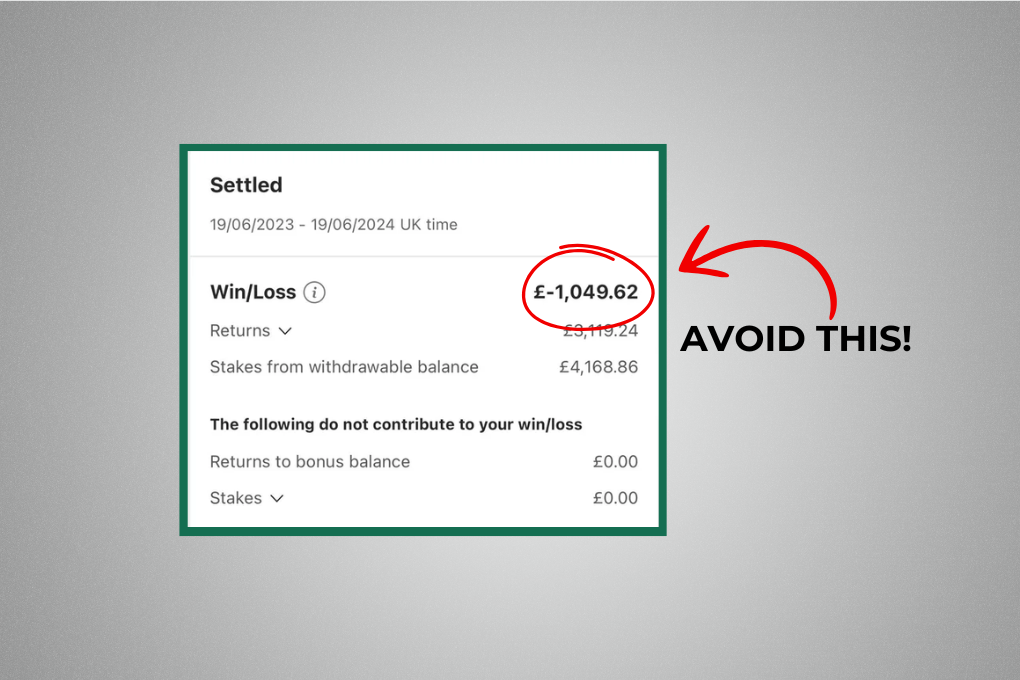If you’re looking to improve your betting game, understanding what not to do is crucial.
Here, we’ll dive into seven popular betting strategies that can lead to losses — and why you should steer clear of them. Each of these tactics is built on common psychological human bias, which the bookmakers know all too well. To overlook them is a mistake!
Let’s look at the worst strategies and why they’re best avoided…
1. It’s Flawed Thinking:
Betting as though past outcomes affect future ones, like assuming a team on a losing streak is “due” a win.
This strategy is built on the Gambler’s Fallacy, where bettors mistakenly believe that past results affect future events. Each game or race is independent, so even if a coin lands tails five times in a row, it’s still a 50/50 chance the next time. You see this sort of thing from football pundits and in the news all the time.
Just look at this from BBC Sport…

The false belief that a team or player is “due” for a win leads to poor betting decisions. The only way to win longer-term is to understand the value and math behind successful bets (more on that in a moment).
2. Even Staking Systems…
What’s your staking plan? Where’s the logic behind it?
Betting the same amount on every bet, no matter the odds or risk involved is foolish. Flat stakes betting appeals to risk-averse bettors looking for a way to limit losses. While consistent staking can slow losses, it does little to increase profits. In fact, it prohibits it.
Treating all bets as equal ignores that some bets are simply better opportunities than others. A more effective approach would be something like the Kelly Criterion where you stake more on high-probability events and less on risky ones, adjusting based on the value each bet offers. Think about it in reverse for a second – bookmakers don’t accept the same amount of bets on every selection now do they?!
No – because it would seal their fate, so don’t let it do the same to your betting.
3. Betting on the Favourite
Yep, people still do this. Consistently betting on the favourite in the belief that they’re more likely to win – and it is (which is where the bias comes from). However, the bookies have already built in a profit margin on the best price.
This betting strategy is a product of “known as outcome bias”. It assumes all favourites are inherently “good” bets. However, only about 35% of favourites win in UK horse racing, for instance.
The kicker is – when they do win, the odds are lower than that chance. Bookmakers know bettors love favourites, so they offer attractive odds with smaller margins to encourage this behaviour—profiting off this common bias. This is why the total gross gambling yield (GGY) was £15.1 billion last year.

4. Beating the Weights Next Week
In racing, people often talk about the handicapper. One of the most talked about approaches is to find under-handicapped horses before their weight adjusts the following week.
It doesn’t work.
The beliefs that drive it are built around confirmation bias, where bettors believe past performances dictate future success (see our first mention). Bookmakers are well aware of this tactic and adjust the odds accordingly, removing any edge that may have emerged.
The result? Gamblers gain false confidence from past performances without accounting for how the odds have changed.
5. Doubling Up Consistently
This classic strategy involves doubling your bet after every loss, aiming to eventually cover all losses with a single win. It’s often referred to as the Martingale System, this method depends on optimism bias—the belief that you can’t keep losing forever. But in reality, losing streaks happen, and each doubled stake adds up fast. After ten consecutive losses on an even-money bet, you’d need a £1,024 bet to win back just £1.
Most bettors run out of money (or hit the bookmaker’s limit) long before recouping losses. The Martingale System is a fast track to a depleted bankroll.
There have been many famous studies around this strategy as it’s so popular. The results are the same every time. Failure.
6. Chasing Losses
We’ve all been there, right? well maybe once anyway.
Increasing bets to try and recover previous losses quickly is a fools errand. Loss aversion is the motivator here—the desire to avoid the pain of losing. It’s the key recipe for disaster.
When on a losing streak, increasing your bets only magnifies potential losses. The odds of winning remain the same. The result is often a downward spiral of betting beyond your means, leading to an empty bankroll. The best way to handle losses is to stick to a planned strategy and avoid impulse bets made in frustration. Remember, betting patterns should reflect real-world value. The better the odds are (for you) the larger the staking should be, the worse, the lower. Don’t break away from that…
7. The Near Miss Fallacy
We’ve all had a near miss in the past – but trust me when I say; it was just variance.
Believing you’re “close” to winning big because you nearly won is insanity. Near Miss Fallacy plays on the illusion of control and dopamine release—the same brain chemical tied to rewards. For example, if five out of six legs on your accumulator win, it feels as though a big win is “just around the corner.” However, each new bet is a standalone event; your previous close call doesn’t influence future outcomes. This mindset often leads to “going large” on the next attempt, risking more money based on a flawed assumption.
Final Thoughts: Avoiding Costly Betting Mistakes
Each of these strategies has a psychological hook that feels right but leads to long-term losses. Bookmakers understand these cognitive biases and often encourage betting behaviours that increase their profits. Staying mindful of these common traps can help you make smarter decisions and avoid unnecessary losses.
Staying mindful of these common traps can help you make smarter decisions and avoid unnecessary losses. For proven betting strategies, check out the link below…
Related: Comprehensive Guide to Betfair Trading – What, How and Why

